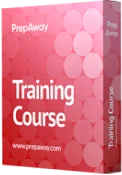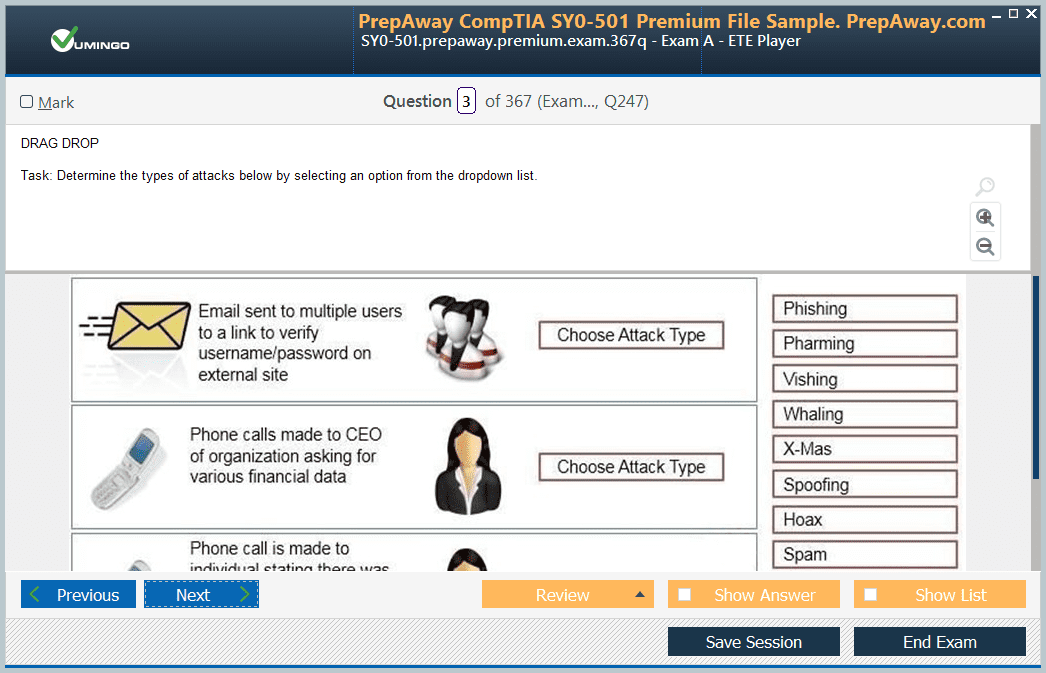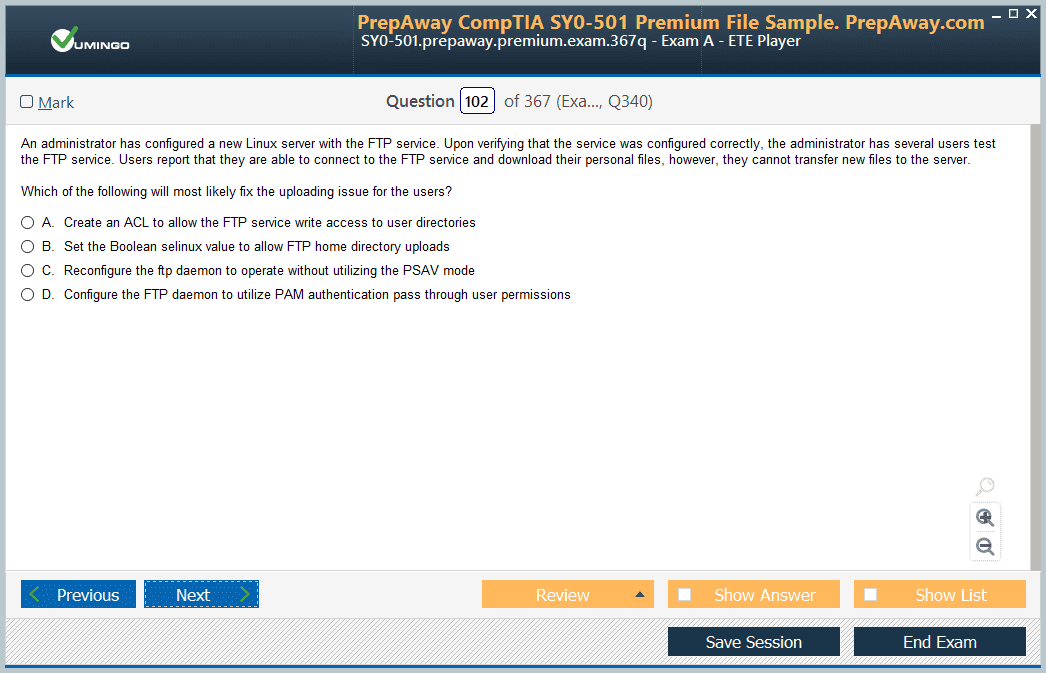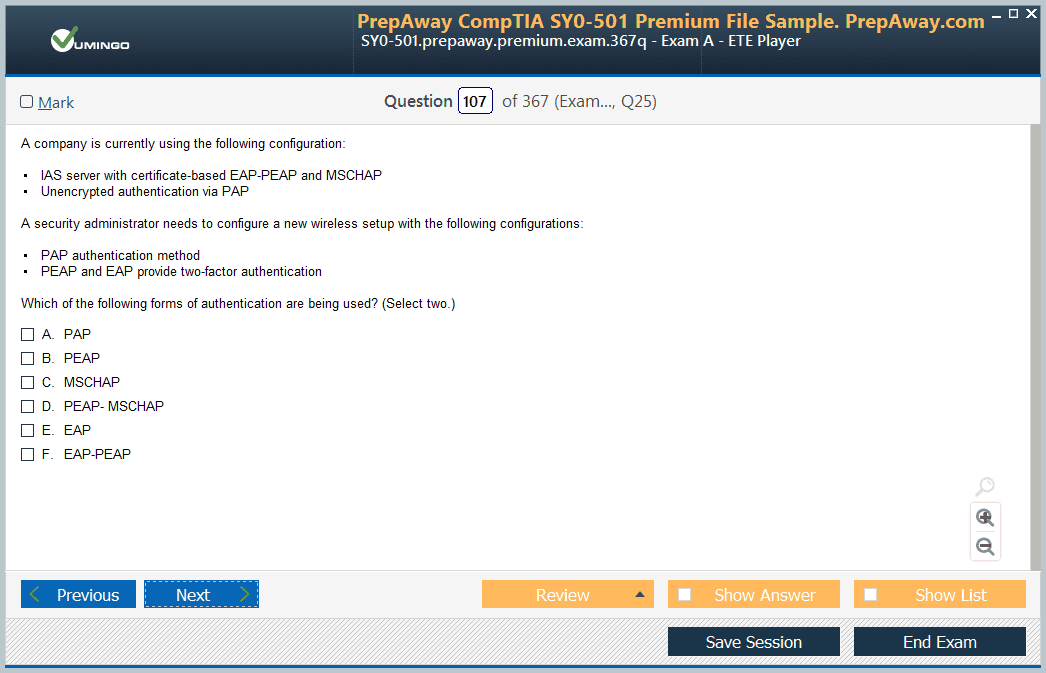- Home
- CompTIA Certifications
- 220-1102 CompTIA A+ Certification Exam: Core 2 Dumps
Pass CompTIA 220-1102 Exam in First Attempt Guaranteed!
Get 100% Latest Exam Questions, Accurate & Verified Answers to Pass the Actual Exam!
30 Days Free Updates, Instant Download!


220-1102 Premium Bundle
- Premium File 677 Questions & Answers. Last update: Dec 29, 2025
- Training Course 296 Video Lectures
- Study Guide 3030 Pages
Last Week Results!

Includes question types found on the actual exam such as drag and drop, simulation, type-in and fill-in-the-blank.

Based on real-life scenarios similar to those encountered in the exam, allowing you to learn by working with real equipment.

Developed by IT experts who have passed the exam in the past. Covers in-depth knowledge required for exam preparation.
All CompTIA 220-1102 certification exam dumps, study guide, training courses are Prepared by industry experts. PrepAway's ETE files povide the 220-1102 CompTIA A+ Certification Exam: Core 2 practice test questions and answers & exam dumps, study guide and training courses help you study and pass hassle-free!
CompTIA A+ 220-1102 Exam Prep: A Step-by-Step Guide
Are you planning to take the CompTIA A+ 220-1102 (Core 2) exam? This certification is an essential step for anyone aiming to begin a career as an entry-level IT professional. It validates the candidate’s ability to install, configure, maintain, and troubleshoot software and operating systems. CompTIA A+ 220-1102 certification equips professionals with the knowledge to handle IT support tasks efficiently and effectively. By mastering this certification, individuals can gain a strong foundation in computing and troubleshooting, which serves as a stepping stone to advanced IT certifications.
Skills Gained from CompTIA A+ 220-1102 (Core 2) Certification
The CompTIA A+ 220-1102 (Core 2) certification provides a wide range of practical skills. Candidates will learn to install, configure, and maintain computer hardware, mobile devices, and software applications for end users. They will acquire knowledge of networking fundamentals and basic cybersecurity measures to mitigate threats. Troubleshooting skills are enhanced through real-world scenarios involving hardware and software issues. Candidates also develop the ability to document problems, apply communication skills in customer support, and understand the basics of scripting, virtualization, and cloud technologies. The certification ensures proficiency across multiple operating systems, including Windows, macOS, Linux, Chrome OS, and mobile platforms.
Who Should Take CompTIA A+ 220-1102 (Core 2) Exam
CompTIA A+ 220-1102 is ideal for individuals pursuing careers in IT support and technical services. It is suitable for IT support technicians, desktop support analysts, field service technicians, junior IT administrators, IT consultants, and professionals seeking to enhance their knowledge of hardware, software, and troubleshooting. Those aiming to enter the IT field or add credentials to their resumes will find this certification highly beneficial. Organizations value this certification because it demonstrates an individual’s ability to configure, deploy, and troubleshoot hardware and software technologies effectively. This makes certified professionals attractive candidates for entry-level IT positions.
Importance of CompTIA A+ 220-1102 Certification
The certification highlights a candidate’s knowledge and skills in the installation, configuration, and troubleshooting of hardware and software. It can lead to career advancement by opening opportunities in technical support and IT operational roles. Positions such as support specialists, field service technicians, and desktop support analysts are commonly associated with this certification and offer competitive salaries. Support specialists may earn around $54,500 per year, field service technicians approximately $46,000, and desktop support analysts about $60,000 annually. By earning this certification, professionals demonstrate their readiness to handle IT responsibilities and contribute to organizational efficiency.
Learning Outcomes from CompTIA A+ 220-1102 Certification
The CompTIA A+ 220-1102 exam equips candidates with comprehensive knowledge across multiple domains. Candidates learn to identify, use, and connect various hardware components and devices. They gain the ability to install and support operating systems, including Windows, macOS, Linux, Chrome OS, Android, and iOS. Software troubleshooting skills are developed, covering issues related to operating systems, malware, and security. Networking fundamentals, such as TCP/IP, Wi-Fi, and SOHO configurations, are also included. Candidates acquire skills to diagnose and resolve real-world device and network problems quickly. The certification ensures understanding of security best practices, mobile device management, virtualization, cloud computing, and operational procedures, including safety, documentation, and communication protocols.
Prerequisites for CompTIA A+ 220-1102 Certification
To be eligible for the CompTIA A+ 220-1102 exam, candidates should possess basic computer literacy and familiarity with networking concepts. Hands-on experience of six to twelve months in roles such as help desk support, desktop support, or field service technician is recommended. While there are no mandatory prerequisites, prior knowledge and experience in IT support tasks significantly improve the likelihood of success. Candidates should be comfortable working with multiple operating systems, troubleshooting hardware and software, and understanding basic networking and security concepts.
Exam Format for CompTIA A+ 220-1102 Certification
The CompTIA A+ 220-1102 exam consists of multiple-choice questions, performance-based items, and drag-and-drop activities. The test is designed to assess practical skills and theoretical knowledge in real-world scenarios. Candidates are expected to solve problems related to software troubleshooting, operating system installation and configuration, networking, security, and operational procedures. Time management is critical as the exam typically includes a set number of questions that must be completed within a specified timeframe. The format ensures that candidates demonstrate both knowledge and practical skills applicable to IT support roles.
Exam Domains and Weightage
The CompTIA A+ 220-1102 exam covers four primary domains. Each domain carries specific weightage: operating systems at 31 percent, security at 25 percent, software troubleshooting at 22 percent, and operational procedures at 22 percent. These domains encompass essential IT skills and knowledge required for entry-level IT roles. Candidates must focus on understanding the structure and expectations of each domain to prepare effectively. Exam questions are scenario-based, testing practical problem-solving skills along with conceptual understanding.
Operating Systems Domain
The operating systems domain includes identification and usage of Microsoft Windows features, command-line tools, and client support utilities. Candidates learn to configure networking features, manage Windows settings, and install applications. Knowledge of macOS, Linux, Chrome OS, and mobile operating systems is also assessed. This domain ensures that candidates can navigate, configure, and troubleshoot various operating systems commonly used in corporate and personal environments.
Security Domain Overview
The security domain of CompTIA A+ 220-1102 focuses on protecting devices, networks, and data from a variety of threats. Security is a critical skill for IT professionals as it ensures the confidentiality, integrity, and availability of information. Candidates are required to demonstrate knowledge of security protocols, authentication methods, malware prevention, social engineering, and securing both wired and wireless networks. This domain emphasizes proactive and reactive measures to mitigate security risks and maintain a secure IT environment. Candidates must also understand common vulnerabilities and methods to address them efficiently.
Understanding Security Measures
Security measures include a range of techniques and tools designed to protect computers, networks, and mobile devices. Candidates will learn how to implement firewalls, antivirus software, encryption, and password management practices. Understanding the purpose of these measures allows IT professionals to make informed decisions to prevent unauthorized access and data breaches. Security measures also involve monitoring for potential threats and taking immediate action to address vulnerabilities. Knowledge of endpoint security, network monitoring, and threat detection is essential to ensure a robust defense against attacks.
Wireless Security and Authentication
Wireless security involves protecting wireless networks such as Wi-Fi from unauthorized access. Candidates must understand encryption protocols such as WPA, WPA2, and WPA3. Knowledge of authentication methods, including multi-factor authentication, is crucial for securing access to sensitive systems. Understanding the differences between public, private, and enterprise networks helps IT professionals configure networks appropriately. Candidates are also expected to know how to detect unauthorized devices, prevent man-in-the-middle attacks, and maintain secure connections for end-users in both corporate and home office environments.
Malware Identification and Prevention
Malware, including viruses, worms, ransomware, and spyware, poses a significant risk to IT systems. The exam requires candidates to identify, remove, and prevent malware using appropriate tools and techniques. Knowledge of malware symptoms, such as unusual system behavior, unexpected pop-ups, and slow performance, is essential. Candidates must also understand the importance of regularly updating antivirus software, performing system scans, and educating users on safe computing practices. Malware prevention is closely tied to user behavior, network security, and system updates.
Social Engineering and Threat Awareness
Social engineering attacks, such as phishing and pretexting, exploit human behavior to gain unauthorized access to systems or sensitive information. Candidates must be able to recognize the signs of social engineering and implement measures to prevent it. This includes training users, monitoring email communication, and enforcing organizational security policies. Awareness of common attack vectors, including email scams, phone calls, and physical access attempts, helps IT professionals safeguard networks and devices. Understanding human-centric threats is as important as technical security measures.
Security Configuration and Best Practices
Configuring workstations and networks according to best practices is an essential skill for IT professionals. Candidates should know how to apply security settings, install and configure firewalls, manage user permissions, and ensure secure system configurations. Best practices also include regularly updating operating systems, applying patches, and maintaining logs for auditing purposes. Securing mobile and embedded devices, implementing data encryption, and following proper disposal methods for sensitive data are also part of the domain. Candidates must be able to balance usability and security effectively.
Software Troubleshooting Domain Overview
The software troubleshooting domain covers identifying, diagnosing, and resolving issues with operating systems, applications, and mobile devices. IT professionals need to develop strong analytical skills to efficiently address problems while minimizing downtime. This domain evaluates candidates’ ability to troubleshoot common PC and mobile device issues, apply best practices for malware removal, and manage system updates. Software troubleshooting skills are critical for IT support roles, ensuring that end users can operate devices without significant interruptions.
Troubleshooting Operating Systems
Candidates must be able to resolve problems related to Windows, macOS, Linux, Chrome OS, and mobile operating systems. This includes installation errors, update failures, driver conflicts, and system crashes. Understanding the operating system architecture, system logs, error messages, and recovery options is vital for effective troubleshooting. Candidates should know how to use built-in diagnostic tools, command-line utilities, and task management features to resolve issues efficiently. They must also understand the importance of backup and recovery procedures to prevent data loss during troubleshooting.
Malware Troubleshooting
Software troubleshooting also involves addressing security issues caused by malware infections. Candidates should be able to identify malware symptoms, perform system scans, remove infections, and restore affected files. Knowledge of safe mode operations, malware removal tools, and system restore techniques is essential. Candidates must also advise end-users on preventive measures, such as avoiding suspicious downloads, keeping antivirus software up to date, and following secure browsing practices. Efficient malware troubleshooting minimizes the risk of repeated infections and ensures system stability.
Mobile Device Troubleshooting
Mobile devices present unique challenges due to their operating systems, connectivity options, and application environments. Candidates must troubleshoot mobile operating systems such as Android and iOS, including application errors, connectivity issues, and security vulnerabilities. This requires familiarity with mobile device settings, app management, backup procedures, and security configurations. Mobile device troubleshooting also involves understanding network connections, data synchronization, and cloud-based services. Candidates must develop the ability to resolve issues quickly to support end-user productivity.
Application Troubleshooting
Application troubleshooting focuses on diagnosing and resolving problems with software applications. Candidates should know how to identify application errors, compatibility issues, and installation problems. Knowledge of system logs, event viewers, and error messages helps in pinpointing the cause of application failures. Candidates must also understand update management, licensing considerations, and software configuration settings. Effective application troubleshooting ensures that software operates reliably, meeting the needs of end-users and minimizing operational disruptions.
Operational Procedures Domain Overview
Operational procedures encompass best practices for managing IT environments, supporting end-users, and maintaining organizational efficiency. This domain evaluates candidates’ understanding of documentation, safety, environmental impacts, change management, and professional communication. Candidates must be able to follow standard operating procedures, implement backup and recovery plans, and utilize remote access technologies. Operational procedures ensure that IT tasks are performed consistently, safely, and in compliance with organizational policies.
Documentation and Information Management
Proper documentation is critical for tracking IT operations, troubleshooting steps, and configuration changes. Candidates should maintain clear and accurate records of incidents, system configurations, and updates. Documentation supports knowledge transfer, audits, and compliance requirements. Information management also includes categorizing, storing, and securing sensitive data. Candidates must understand the importance of confidentiality and access control while ensuring that information is available to authorized personnel when needed.
Change Management and Backup Procedures
Change management involves systematically handling modifications to systems, networks, and applications. Candidates must understand the impact of changes, obtain approvals, and document the implementation process. Backup and recovery procedures are essential for protecting data against loss or corruption. Candidates should be able to configure automated backups, verify integrity, and restore systems efficiently. Knowledge of disaster recovery strategies and business continuity plans is crucial for maintaining operational stability.
Safety and Environmental Considerations
IT professionals must follow safety guidelines to protect themselves and end-users from hazards. This includes proper handling of equipment, avoiding electrical risks, and maintaining ergonomic workspaces. Environmental considerations involve responsible disposal of electronic waste, energy-efficient practices, and compliance with local regulations. Candidates must understand the impact of technology on the environment and apply best practices to minimize negative effects while ensuring operational efficiency.
Professional Communication and Remote Access
Effective communication skills are vital for IT professionals to interact with colleagues, clients, and end-users. Candidates should be able to explain technical issues clearly, provide instructions, and document support activities. Remote access technologies are commonly used for troubleshooting and support, and candidates must understand secure methods for accessing systems remotely. Maintaining professionalism, adhering to policies, and demonstrating ethical behavior are important aspects of operational procedures.
Scripting and Virtualization Basics
Candidates are expected to have a basic understanding of scripting, which can automate repetitive tasks and enhance efficiency. Knowledge of command-line interfaces, batch files, and scripting fundamentals is beneficial for troubleshooting and configuration. Virtualization allows multiple operating systems to run on a single physical machine. Candidates should understand the concept, setup, and usage of virtual machines, as well as the advantages of virtualization for testing, training, and deployment. These skills support operational efficiency and problem-solving capabilities in IT environments.
Selecting Study Materials
Choosing the right study materials is essential for efficient exam preparation. Candidates should start with official study guides that outline the exam objectives, domains, and skills required. These guides provide structured content that ensures all relevant topics are covered. Books covering both Core 1 and Core 2 provide comprehensive explanations, diagrams, and examples. Candidates benefit from reading materials that break down complex topics into manageable sections, making it easier to understand concepts such as operating system configurations, troubleshooting procedures, and security protocols. Study materials should also include summaries, review questions, and practice exercises to reinforce learning.
Instructor-Led Training and Video Courses
Instructor-led training and video courses offer interactive and visual learning experiences. Candidates can watch demonstrations, follow step-by-step instructions, and engage with real-world scenarios. These courses provide explanations of complicated topics, practical examples, and troubleshooting walkthroughs. Video lessons help reinforce understanding of operating systems, networking fundamentals, and security best practices. Candidates can revisit videos for revision and focus on areas where they face difficulties. Live or recorded courses often provide opportunities to ask questions, clarify doubts, and gain insights from experienced IT instructors.
Hands-On Practice and Labs
Practical experience is critical for mastering the skills required for the CompTIA A+ 220-1102 exam. Hands-on labs allow candidates to apply concepts learned from study materials in real-world scenarios. This includes installing operating systems, configuring software applications, troubleshooting hardware issues, setting up networks, and implementing security measures. Virtual labs and simulated environments provide safe spaces for experimentation without affecting live systems. Candidates can practice tasks repeatedly until they gain confidence. Hands-on experience enhances understanding of exam objectives, improves problem-solving abilities, and ensures readiness for performance-based questions.
Practice Tests and Self-Assessment
Practice tests are invaluable tools for exam preparation. They simulate the actual exam environment, allowing candidates to gauge their knowledge, evaluate timing, and identify weak areas. Multiple practice exams should be attempted throughout the preparation process to track progress. Analyzing incorrect answers helps candidates understand gaps in knowledge and refine their study plan. Timed practice tests improve time management skills, ensuring candidates can complete all questions within the allotted exam duration. Consistent self-assessment builds confidence and reduces anxiety on exam day.
Understanding Exam Objectives
Familiarity with exam objectives is crucial for focused preparation. Candidates should thoroughly review the official exam domains and understand the skills and knowledge required for each. Clear comprehension of domain weightage allows candidates to allocate study time effectively, prioritizing areas with higher impact. Understanding the objectives ensures that candidates are not surprised by unfamiliar topics and can anticipate the types of questions they may encounter. A well-structured study plan aligned with exam objectives increases efficiency and maximizes the chances of success.
Creating a Study Schedule
A well-defined study schedule helps candidates manage their time and cover all exam domains systematically. The schedule should break down topics into daily or weekly segments, allocating more time to complex or heavily weighted domains. Consistent study sessions prevent information overload and ensure steady progress. Candidates should incorporate time for hands-on practice, video lessons, reading, and review. Regular breaks, revision sessions, and practice tests should also be included to reinforce learning. Flexibility in the schedule allows adjustments based on progress, ensuring all domains are adequately covered before the exam.
Time Management Strategies
Effective time management is essential for both preparation and exam performance. Candidates should allocate specific time blocks for studying each domain, practicing hands-on exercises, and completing practice tests. During the exam, managing time ensures that all questions are answered accurately and completely. Candidates should practice pacing themselves during mock exams, prioritizing easier questions first and revisiting challenging questions later. Developing a rhythm for answering questions reduces stress and increases accuracy. Time management skills are critical to ensure comprehensive preparation and confident performance on exam day.
Note-Taking and Review Techniques
Taking organized notes while studying helps candidates retain information and provides a quick reference for revision. Notes should summarize key concepts, commands, procedures, and troubleshooting steps. Using diagrams, flowcharts, and tables can make complex topics easier to understand. Regular review of notes reinforces learning and highlights areas that require additional attention. Candidates can also create flashcards for important terms, commands, and definitions to facilitate quick recall. Consistent note-taking and review contribute to a deeper understanding and long-term retention of exam content.
Exam-Taking Strategies
Adopting effective exam-taking strategies improves performance and reduces anxiety. Candidates should carefully read each question, identify key points, and consider all answer options. Scenario-based questions require analytical thinking and application of practical knowledge. Candidates should eliminate incorrect answers to increase the likelihood of selecting the correct option. For performance-based questions, methodical and logical problem-solving approaches ensure accurate results. Staying calm, pacing oneself, and maintaining focus throughout the exam are essential for success.
Leveraging Online Communities
Engaging with online communities and discussion forums allows candidates to exchange knowledge, ask questions, and gain insights from peers. Communities provide support, motivation, and practical advice from individuals who have already taken the exam. Candidates can discuss difficult concepts, share resources, and learn tips for exam preparation. Participation in communities also exposes candidates to a variety of problem-solving approaches and real-world experiences, enhancing their understanding of practical IT scenarios.
Tracking Progress and Adapting Study Plan
Regularly assessing progress helps candidates adapt their study plan to focus on areas needing improvement. Candidates should track performance in practice tests, monitor understanding of each domain, and adjust study time accordingly. Reviewing incorrect answers and understanding the reasoning behind correct responses is critical. Flexibility in the study plan allows candidates to allocate additional time to challenging topics, revisit hands-on exercises, and strengthen weak areas. Continuous self-evaluation ensures that candidates remain on track for exam readiness.
Revising Exam Domains
Revision is an essential phase of exam preparation. Candidates should systematically review each domain, reinforcing key concepts, procedures, and troubleshooting steps. Revisiting operating systems, security, software troubleshooting, and operational procedures helps solidify knowledge. Revision should include reading notes, practicing lab exercises, and attempting scenario-based questions. Candidates should focus on understanding rather than memorization, as the exam tests the application of knowledge in real-world situations. Regular revision ensures retention of critical information and enhances confidence.
Building Confidence
Confidence plays a significant role in exam success. Candidates should build confidence through consistent study, hands-on practice, and repeated testing. Understanding the exam format, familiarizing oneself with performance-based questions, and mastering exam domains reduce anxiety. Positive reinforcement, goal setting, and tracking progress contribute to self-assurance. Candidates should approach the exam with a mindset of problem-solving and practical application, trusting their preparation and skills. Confidence ensures calmness and focus during the actual test, leading to better performance.
Preparing for Exam Day
Exam day preparation involves both mental and physical readiness. Candidates should ensure adequate rest, proper nutrition, and a clear mind before the exam. Arriving early, familiarizing oneself with the testing environment, and bringing required identification and materials are essential steps. Candidates should remain calm, read instructions carefully, and manage time effectively during the exam. A focused and relaxed mindset enhances problem-solving abilities and reduces mistakes. Preparation for exam day complements prior study efforts and maximizes the likelihood of success.
Post-Exam Reflection and Next Steps
After completing the exam, candidates should reflect on their performance and identify areas for future improvement. Regardless of the outcome, reviewing the exam experience provides insights into strengths and weaknesses. Passing the CompTIA A+ 220-1102 exam opens opportunities for entry-level IT positions and lays the foundation for advanced certifications. Candidates can continue learning, gaining practical experience, and exploring specialized areas such as networking, cybersecurity, and cloud computing. Continuous skill development ensures long-term career growth and professional advancement in the IT industry.
Final Preparation Tips for CompTIA A+ 220-1102 Exam
Final preparation for the CompTIA A+ 220-1102 exam involves reviewing all domains, reinforcing hands-on experience, and practicing exam strategies. Candidates should allocate time for last-minute revision, focusing on weaker areas identified through practice tests. Repetition of practical exercises, such as operating system installation, software troubleshooting, and configuring security settings, enhances confidence. Reviewing notes, flashcards, and summaries ensures important concepts are retained. It is crucial to maintain a calm and focused mindset, avoiding cramming just before the exam. Staying consistent with revision and practicing under timed conditions simulates the real exam environment, improving readiness.
Reviewing Exam Domains
A comprehensive review of all exam domains is essential for final preparation. Candidates should revisit operating systems, ensuring familiarity with Windows, macOS, Linux, Chrome OS, and mobile operating systems. Practicing installation, configuration, and troubleshooting tasks consolidates knowledge. Security concepts, including malware prevention, wireless security, authentication methods, and social engineering awareness, must be reviewed thoroughly. Software troubleshooting exercises, including identifying application errors, OS issues, and mobile device problems, help sharpen diagnostic skills. Operational procedures, such as documentation, backup processes, safety measures, change management, and professional communication, should be reinforced. This domain-focused review ensures candidates are well-prepared for all aspects of the exam.
Importance of Hands-On Practice
Hands-on practice is critical for passing the CompTIA A+ 220-1102 exam. Practical exercises allow candidates to apply theoretical knowledge to real-world scenarios. Tasks such as setting up networks, configuring devices, implementing security measures, and troubleshooting errors provide experiential learning that cannot be achieved through reading alone. Virtual labs, simulations, and practice environments offer safe spaces for repeated experimentation. By mastering practical skills, candidates gain confidence in handling performance-based questions and develop problem-solving abilities that are essential in professional IT roles. Regular hands-on practice complements study materials and ensures comprehensive exam preparation.
Time Management Before the Exam
Time management is a key factor in ensuring readiness for the exam. Candidates should divide study sessions across all domains while leaving time for revision and practice tests. During preparation, allocating specific time blocks for reading, hands-on exercises, and self-assessment helps maintain a balanced approach. Practicing under timed conditions familiarizes candidates with exam pacing and reduces the likelihood of time-related stress. Effective time management ensures all topics are adequately covered and allows candidates to focus on areas requiring improvement. This disciplined approach enhances efficiency and readiness for the actual exam.
Mental and Physical Readiness
Mental and physical readiness is as important as academic preparation. Candidates should ensure adequate sleep, maintain a healthy diet, and stay hydrated before the exam. Regular breaks during study sessions prevent burnout and improve retention. Practicing relaxation techniques, such as deep breathing or mindfulness, helps manage anxiety and maintain focus. A positive mindset boosts confidence, enabling candidates to approach the exam calmly and effectively. Mental and physical well-being directly influence performance, making it crucial to maintain balance and preparedness throughout the preparation process.
Exam Day Strategies
On exam day, candidates should arrive early to familiarize themselves with the testing environment. It is important to carry the required identification and follow all instructions carefully. Reading each question thoroughly and understanding the scenario ensures accurate responses. Candidates should prioritize easier questions first, then revisit challenging ones to optimize time usage. For performance-based tasks, methodical problem-solving and attention to detail are critical. Maintaining calm and focusing on one question at a time reduces errors. By implementing these strategies, candidates can perform confidently and efficiently during the exam.
Frequently Asked Questions About CompTIA A+ 220-1102
Understanding common queries about the exam helps candidates clarify expectations and prepare effectively. The exam covers both Core 1 and Core 2 content, but Core 2 emphasizes operating systems, software troubleshooting, security, and operational procedures. Candidates typically spend several months preparing, depending on prior experience and study pace. No mandatory prerequisites exist, but familiarity with computer hardware, networking, and IT support roles is recommended. Performance-based questions simulate real-world tasks, requiring practical knowledge rather than rote memorization. Practice tests and hands-on exercises are highly recommended to gain confidence and identify weak areas.
Salary Prospects for CompTIA A+ Certified Professionals
CompTIA A+ certification significantly enhances career prospects and earning potential. Entry-level IT support roles often require this certification, demonstrating practical skills in hardware, software, and troubleshooting. Salaries vary based on role, experience, and location. Support specialists typically earn around $54,500 per year, field service technicians approximately $46,000 per year, and desktop support analysts about $60,000 per year. Other roles, such as junior IT administrators and IT support engineers, may command higher salaries as skills and experience increase. The certification serves as a foundation for career advancement and long-term professional growth in IT.
Career Pathways After CompTIA A+ Certification
CompTIA A+ certification opens multiple career pathways in the IT industry. Candidates can pursue roles in technical support, help desk, desktop support, field service, and IT administration. This certification is recognized globally, allowing professionals to explore opportunities in different organizations and industries. With experience, candidates can advance to specialized areas, including network administration, cybersecurity, cloud computing, and system administration. CompTIA A+ serves as a stepping stone for advanced certifications, enabling professionals to build expertise and take on higher-level IT responsibilities. Continuous learning and hands-on experience further enhance career prospects.
Advanced Certifications and Skill Development
After earning CompTIA A+ 220-1102 certification, professionals can pursue additional certifications to enhance their knowledge and career potential. Network-focused certifications, cybersecurity credentials, and cloud computing qualifications complement A+ skills and broaden career opportunities. Advanced certifications provide specialized knowledge in areas such as network security, virtualization, and enterprise-level IT management. Continuous professional development, hands-on experience, and ongoing training are essential for maintaining competitiveness in the IT field. Building expertise in multiple domains enhances problem-solving capabilities, making professionals valuable assets to their organizations.
Continuous Learning and Practical Experience
Continuous learning is vital for IT professionals to stay current with technology trends and industry standards. Practical experience gained through work, labs, or projects reinforces theoretical knowledge. Candidates should engage with community forums, participate in workshops, and explore new technologies to expand skill sets. Developing proficiency in emerging tools and methodologies ensures adaptability and increases employability. Practical experience combined with certifications creates a strong professional profile, enabling candidates to handle complex IT challenges effectively. Maintaining curiosity and a commitment to learning supports long-term career growth.
Work Environment and Job Responsibilities
CompTIA A+ certified professionals typically work in environments requiring technical support, troubleshooting, and operational management. Responsibilities include installing and configuring software and hardware, maintaining networks, resolving security issues, and assisting end-users. Professionals may work in corporate IT departments, service providers, or small and medium enterprises. The certification equips candidates with the skills to handle various tasks efficiently, from addressing software errors to managing operational procedures. Effective communication, problem-solving, and technical proficiency are key to excelling in these roles.
Ethical and Professional Conduct
Ethical behavior and professionalism are critical aspects of IT work. Candidates must follow organizational policies, respect privacy, and handle sensitive data responsibly. Maintaining integrity in troubleshooting, documenting procedures accurately, and communicating clearly with end-users reflects professional competence. Ethical conduct ensures trustworthiness and reliability, which are essential for long-term career success. CompTIA A+ certification emphasizes professional standards and encourages adherence to best practices in all aspects of IT operations.
Career Advancement Opportunities
CompTIA A+ certification provides a strong foundation for career advancement in IT. Professionals can progress to roles with increased responsibility, including network administration, cybersecurity, systems management, and technical consulting. Certifications and experience enable candidates to take on supervisory or project management roles in IT support teams. Continuous skill enhancement and practical exposure ensure readiness for higher-level challenges. Career growth is facilitated by the combination of theoretical knowledge, practical skills, and recognized certification credentials.
Summary of CompTIA A+ 220-1102 Certification
The CompTIA A+ 220-1102 certification validates essential IT skills for entry-level professionals. Candidates gain knowledge in operating systems, software troubleshooting, security, and operational procedures. The certification equips individuals to install, configure, maintain, and troubleshoot hardware and software, supporting end-users effectively. Preparation involves studying official materials, engaging in hands-on labs, taking practice tests, and following structured exam strategies. Passing the exam opens doors to diverse IT roles and establishes a foundation for advanced certifications and career growth. Continuous learning, ethical conduct, and professional development are key to long-term success in the IT industry.
Conclusion:
Achieving CompTIA A+ 220-1102 certification is a milestone for aspiring IT professionals. The certification demonstrates practical skills, technical knowledge, and the ability to handle real-world IT challenges. By following a structured study plan, practicing hands-on exercises, and utilizing effective exam strategies, candidates can succeed confidently. The certification enhances employability, increases earning potential, and provides a pathway for continuous career development. Maintaining curiosity, gaining experience, and pursuing further certifications ensure growth and advancement in the ever-evolving field of information technology.
CompTIA 220-1102 practice test questions and answers, training course, study guide are uploaded in ETE Files format by real users. Study and Pass 220-1102 CompTIA A+ Certification Exam: Core 2 certification exam dumps & practice test questions and answers are to help students.
- SY0-701 - CompTIA Security+
- N10-009 - CompTIA Network+
- CS0-003 - CompTIA CySA+ (CS0-003)
- 220-1201 - CompTIA A+ Certification Exam: Core 1
- CAS-005 - CompTIA SecurityX
- PT0-003 - CompTIA PenTest+
- 220-1202 - CompTIA A+ Certification Exam: Core 2
- PK0-005 - CompTIA Project+
- CV0-004 - CompTIA Cloud+
- XK0-005 - CompTIA Linux+
- 220-1101 - CompTIA A+ Certification Exam: Core 1
- 220-1102 - CompTIA A+ Certification Exam: Core 2
- XK0-006 - CompTIA Linux+
- SK0-005 - CompTIA Server+ Certification Exam
- FC0-U71 - CompTIA Tech+
- DA0-001 - Data+
- CA1-005 - CompTIA SecurityX
- DS0-001 - CompTIA DataSys+
- CV0-003 - CompTIA Cloud+
- CAS-004 - CompTIA Advanced Security Practitioner (CASP+) CAS-004
- PT0-002 - CompTIA PenTest+ Certification Exam
- CNX-001 - CompTIA CloudNetX
- DY0-001 - CompTIA DataX
- FC0-U61 - CompTIA IT Fundamentals
- CY0-001 - CompTIA SecAI+ Beta
Purchase 220-1102 Exam Training Products Individually



Why customers love us?
What do our customers say?
The resources provided for the CompTIA certification exam were exceptional. The exam dumps and video courses offered clear and concise explanations of each topic. I felt thoroughly prepared for the 220-1102 test and passed with ease.
Studying for the CompTIA certification exam was a breeze with the comprehensive materials from this site. The detailed study guides and accurate exam dumps helped me understand every concept. I aced the 220-1102 exam on my first try!
I was impressed with the quality of the 220-1102 preparation materials for the CompTIA certification exam. The video courses were engaging, and the study guides covered all the essential topics. These resources made a significant difference in my study routine and overall performance. I went into the exam feeling confident and well-prepared.
The 220-1102 materials for the CompTIA certification exam were invaluable. They provided detailed, concise explanations for each topic, helping me grasp the entire syllabus. After studying with these resources, I was able to tackle the final test questions confidently and successfully.
Thanks to the comprehensive study guides and video courses, I aced the 220-1102 exam. The exam dumps were spot on and helped me understand the types of questions to expect. The certification exam was much less intimidating thanks to their excellent prep materials. So, I highly recommend their services for anyone preparing for this certification exam.
Achieving my CompTIA certification was a seamless experience. The detailed study guide and practice questions ensured I was fully prepared for 220-1102. The customer support was responsive and helpful throughout my journey. Highly recommend their services for anyone preparing for their certification test.
I couldn't be happier with my certification results! The study materials were comprehensive and easy to understand, making my preparation for the 220-1102 stress-free. Using these resources, I was able to pass my exam on the first attempt. They are a must-have for anyone serious about advancing their career.
The practice exams were incredibly helpful in familiarizing me with the actual test format. I felt confident and well-prepared going into my 220-1102 certification exam. The support and guidance provided were top-notch. I couldn't have obtained my CompTIA certification without these amazing tools!
The materials provided for the 220-1102 were comprehensive and very well-structured. The practice tests were particularly useful in building my confidence and understanding the exam format. After using these materials, I felt well-prepared and was able to solve all the questions on the final test with ease. Passing the certification exam was a huge relief! I feel much more competent in my role. Thank you!
The certification prep was excellent. The content was up-to-date and aligned perfectly with the exam requirements. I appreciated the clear explanations and real-world examples that made complex topics easier to grasp. I passed 220-1102 successfully. It was a game-changer for my career in IT!












